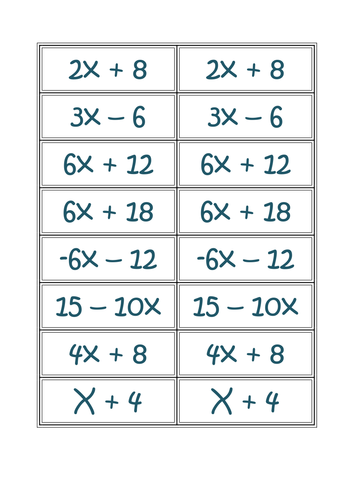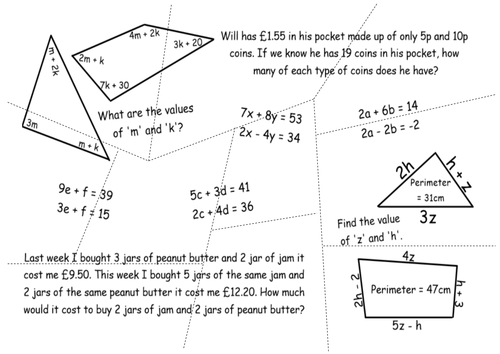87Uploads
286k+Views
254k+Downloads
All resources

Factors, Multiples, LCM and HCF Lesson
A lesson on factors, multiples, highest common factors and lowest common multiples. Contains a range of different activities many of which are differentiated by task. Also included are 2 different tarsia which are also differentiated at green and orange levels.
Have fun!

Mean from a table
Here is a basic lesson on calculating means from a table. It starts by recapping averages then moves on to mean from a table.
I have done it the opposite way round to usual looking at estimated means first then finishing by asking them to look at a mean from a frequency table.

Fraction to Percentage Beer Pong (without beer)
Here is a full lesson on converting fractions to percentages.
However the task at the end is the interesting bit! Pupils need to bounce a ping pong ball into a cup, you give pupil a card telling them how many times to repeat the experiment (10, 20 or 25 times). We then compare the results to see who is the best hopefully they will realise its hard to compare results when we've done different numbers of time. So they will need to convert their answers to percentages!

Which Santa? Cumulative Frequency and Box Plots
Here is a task I made for my class studying GCSE statistics group but also used with my higher group.
Pupils are required to complete a number of tasks to decide who should replace santa; buddy the elf or Fred Claus.
Requires pupils to construct a table of data, cumulative frequency diagram, read information from it, then construct a box blot (box and whisker) and interpret the results.
I prints the pages from the IWB and used them as worksheets!
Enjoy Christmas Maths!

Properties of 3D shapes Catchphrase
Here is a catchphrase covering so key elements of the 3D shape topics including naming 3D shapes, vertices, edges and faces.
A nice way to consolidate the topic.
Click the squares to reveal the catchphrase.

Probability Treasure Hunt
A set of probabilty treasure hunt cards. Pupils to answer a question then line it up with the next question.

Mean, Median and Mode Class Quiz
Here is a catchphrase type activity on averages (mean, median and mode).
When pupils answer questions click the square to remove it. Pupils get points for every star they find under the tile.

3D Shape Quiz
This quiz covers a few key bits of 3D shapes including nets, volumes, naming 3D shapes and cuboids, I also chucked in a random area of triangle questions as well.
As pupils give correct answers click the square to remove it as they move down the tack.

KS3 Single Bracket and Simplifying Match Cards
KS3 activtiy where pupils are required to collect like term to match up expressions then an extension where pupils are required to expand a single bracket and match it up a expression.

Volume of a Sphere
Here is a full lesson on calculating the volume of a sphere.
It contains an introduction, examples of a sphere and a hemisphere, a differentiated worksheet and a plenary.
All solutions are included on the slides.
Hope it helps and happy teaching.

Thoughts and Crosses (Proportion)
An activitiy which can be used a way of providing differentiated questions in class. Pupils to pick 3 questions from the noughts and crosses grid to answer must form a line of 3. Can be used for pupils to answer 3 as an individual or play as a game of noughts and crossses between a pair.
Calculating proportion and best value.

Thoughts and Crosses (Calculating Percentages)
An activitiy which can be used a way of providing differentiated questions in class. Pupils to pick 3 questions from the noughts and crosses grid to answer must form a line of 3. Can be used for pupils to answer 3 as an individual or play as a game of noughts and crossses between a pair.
Percentages.

Sample Space Probability
This is a lesson I made on sample spaces. It is quite class specific so you may need to do a lot of adapting to the middle section to make it fit to your class. Nice question at the end though where I got pupils to work in pairs to justify their answers.

Missing Angle on a Straight Line
This lesson covers the full range on attainments for missing angles on a straight line. It starts with the basics before moving on to forming and solving equations involving angles on a straight line.
The lesson includes;
Starter
Introduction to the topic in small chunks
The use of examples and non-examples to address misconceptions
Clear modelling through “I do” and “You Do” examples.
Multiple choice questions to draw out misconceptions.
Differentiated worksheet.
The lesson includes the solutions and is fully animated which will make it perfect for delivering remote lessons.

Pythagoras Thoughts and Crosses
Pupils to work in a pair draw noughts and crosses grid, but before they can put a nought or cross in the box they must answer to question in the grid.
Found it to a great plenary to test pupils knowledge on pythagoras' theorem.

GCSE Unit 1 Revision - thoughts and crosses
An activity for pupils to play in pairs based on blooms. Just as in normal noughts and crosses pupils need to make a line of 3, but instead of nought and crosses they must write their answer in a noughts and crosses grid.
As an extension for those who finish I get them to work as a pair to complete the rest of the grid.

Area of a Circle (Worlds biggest pizza)
A lesson I designed on calculating the circumference of a cricle. Based around the wprlds biggest pizza. A section in middle where pupils try and come up with the formula by cutting up circles, printable sheet on last slide.
It also has a nice differentiated problem solving task at the end where pupils are required to apply knowledge.
A slide on what do we need to know where pupils need to brainstorm what things they need to answer the question before they are giving any information.

Thoughts and crosses - Linear Graphs (y=mx+c)
An activity for pupils to play in pairs based on blooms or a way to provide differentiated questioning to pupils. Just as in normal noughts and crosses pupils need to make a line of 3, but instead of nought and crosses they must write their answer in a noughts and crosses grid. As an extension for those who finish I get them to work

Solving Simultaneous Equations
A great lesson on solving simultaneous equations using elimination.
It contains a variety of examples with differentiated questions, a jigsaw puzzle and a team game towards the end which the pupils loved. It includes both worded questions and standard algebraic questions.
I have included teacher hints on each slide to help you find the hidden tabs on the IWB. Please delete these out before you use it in the classroom.
All the solutions are included!
Enjoy :-)

GCSE Unit 1 Revision Thoughts and Crosses 2
An activity for pupils to play in pairs based on blooms. Just as in normal noughts and crosses pupils need to make a line of 3, but instead of nought and crosses they must write their answer in a noughts and crosses grid. As an extension for those who finish I get them to work as a pair to complete the rest of the grid.




















